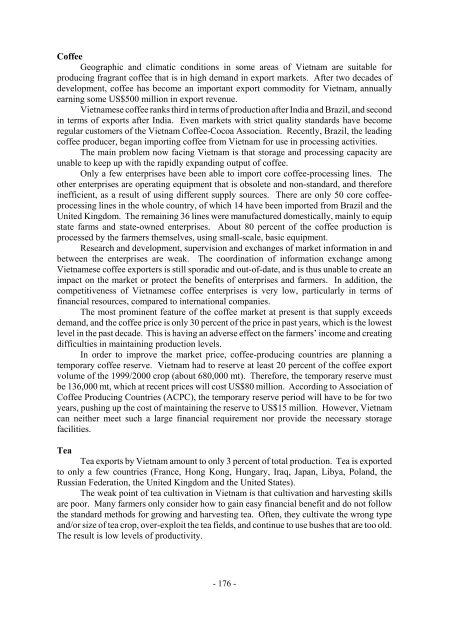Development of Agribusiness Enterprises - Asian Productivity ...
Development of Agribusiness Enterprises - Asian Productivity ...
Development of Agribusiness Enterprises - Asian Productivity ...
Create successful ePaper yourself
Turn your PDF publications into a flip-book with our unique Google optimized e-Paper software.
C<strong>of</strong>fee<br />
Geographic and climatic conditions in some areas <strong>of</strong> Vietnam are suitable for<br />
producing fragrant c<strong>of</strong>fee that is in high demand in export markets. After two decades <strong>of</strong><br />
development, c<strong>of</strong>fee has become an important export commodity for Vietnam, annually<br />
earning some US$500 million in export revenue.<br />
Vietnamese c<strong>of</strong>fee ranks third in terms <strong>of</strong> production after India and Brazil, and second<br />
in terms <strong>of</strong> exports after India. Even markets with strict quality standards have become<br />
regular customers <strong>of</strong> the Vietnam C<strong>of</strong>fee-Cocoa Association. Recently, Brazil, the leading<br />
c<strong>of</strong>fee producer, began importing c<strong>of</strong>fee from Vietnam for use in processing activities.<br />
The main problem now facing Vietnam is that storage and processing capacity are<br />
unable to keep up with the rapidly expanding output <strong>of</strong> c<strong>of</strong>fee.<br />
Only a few enterprises have been able to import core c<strong>of</strong>fee-processing lines. The<br />
other enterprises are operating equipment that is obsolete and non-standard, and therefore<br />
inefficient, as a result <strong>of</strong> using different supply sources. There are only 50 core c<strong>of</strong>feeprocessing<br />
lines in the whole country, <strong>of</strong> which 14 have been imported from Brazil and the<br />
United Kingdom. The remaining 36 lines were manufactured domestically, mainly to equip<br />
state farms and state-owned enterprises. About 80 percent <strong>of</strong> the c<strong>of</strong>fee production is<br />
processed by the farmers themselves, using small-scale, basic equipment.<br />
Research and development, supervision and exchanges <strong>of</strong> market information in and<br />
between the enterprises are weak. The coordination <strong>of</strong> information exchange among<br />
Vietnamese c<strong>of</strong>fee exporters is still sporadic and out-<strong>of</strong>-date, and is thus unable to create an<br />
impact on the market or protect the benefits <strong>of</strong> enterprises and farmers. In addition, the<br />
competitiveness <strong>of</strong> Vietnamese c<strong>of</strong>fee enterprises is very low, particularly in terms <strong>of</strong><br />
financial resources, compared to international companies.<br />
The most prominent feature <strong>of</strong> the c<strong>of</strong>fee market at present is that supply exceeds<br />
demand, and the c<strong>of</strong>fee price is only 30 percent <strong>of</strong> the price in past years, which is the lowest<br />
level in the past decade. This is having an adverse effect on the farmers’ income and creating<br />
difficulties in maintaining production levels.<br />
In order to improve the market price, c<strong>of</strong>fee-producing countries are planning a<br />
temporary c<strong>of</strong>fee reserve. Vietnam had to reserve at least 20 percent <strong>of</strong> the c<strong>of</strong>fee export<br />
volume <strong>of</strong> the 1999/2000 crop (about 680,000 mt). Therefore, the temporary reserve must<br />
be 136,000 mt, which at recent prices will cost US$80 million. According to Association <strong>of</strong><br />
C<strong>of</strong>fee Producing Countries (ACPC), the temporary reserve period will have to be for two<br />
years, pushing up the cost <strong>of</strong> maintaining the reserve to US$15 million. However, Vietnam<br />
can neither meet such a large financial requirement nor provide the necessary storage<br />
facilities.<br />
Tea<br />
Tea exports by Vietnam amount to only 3 percent <strong>of</strong> total production. Tea is exported<br />
to only a few countries (France, Hong Kong, Hungary, Iraq, Japan, Libya, Poland, the<br />
Russian Federation, the United Kingdom and the United States).<br />
The weak point <strong>of</strong> tea cultivation in Vietnam is that cultivation and harvesting skills<br />
are poor. Many farmers only consider how to gain easy financial benefit and do not follow<br />
the standard methods for growing and harvesting tea. Often, they cultivate the wrong type<br />
and/or size <strong>of</strong> tea crop, over-exploit the tea fields, and continue to use bushes that are too old.<br />
The result is low levels <strong>of</strong> productivity.<br />
- 176 -
















